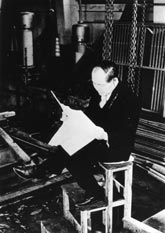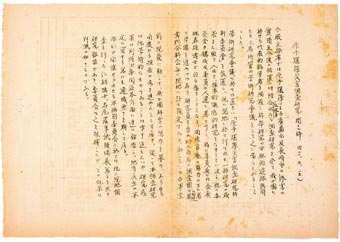Towards Production of an A-bomb Documentary Film
Upon receiving word of the destruction of Hiroshima, the Japan Film Corporation, the single producer of newsreels in Japan, immediately dispatched a team of cameramen to Hiroshima where they recorded on film the deplorable conditions. At the same time, the cultural film department of the Japan Film Corporation began studying the possibility of a documentary on A-bomb damage. By early September, the company formally decided to produce such a film. Even amidst the postwar turmoil, the staff prepared to create a true film record of actual conditions in Hiroshima and Nagasaki.

[9]
Hiroshima, as it appeared to production staff member embarking on unaccompanied survey
September 12, 1945
Photo by Entaro Yamagami Courtesy of Mainichi Shimbun
As preparation for filming was proceeding, production staff member Sueo Ito departed for Hiroshima and Nagasaki on September 7. While walking through the charred ruins in Hiroshima, he formed ideas of what to film. He also visited the prefectural government office and informed officials that a group consisting of a camera crew and other production staff members would be arriving in Hiroshima shortly.
|
 [10] [10] |
[10]
Yoshio Nishina, editorial supervisor of film
Photo by Shunkichi Kikuchi
Hidetsugu Aihara wished to record the status of damage and injuries accurately and scientifically. Thus, when filming was formally approved by the Japan Film Corporation, he asked Yoshio Nishina to be the film's editorial supervisor. Nishina was a leading expert in nuclear physics and senior researcher at the Institute of Physical and Chemical Research. |

[12]
Establishment of Special Committee for the Investigation of A-bomb Damages
Donated by Kenichi Suge
Nishina believed that it was necessary to mobilize a broad range of academic scholars for the film's production, so he contacted the Ministry of Education. On September 14 a "Special Committee for the Investigation of A-bomb Damages" was established in the Ministry of Education's Scientific Research Council of Japan. The plan was to dispatch an academic survey team of about two hundred investigators to Hiroshima and Nagasaki. On September 14, the formation of a 33-member film production staff was also determined. The camera crew was divided into five teams: a biology team, physics team, civil engineering and architectural team, medical team, and news and field reporting team. The film production crew was assigned to film on-site as a subsidiary body of the committee. |
[11]
Film production draft
Donated by Peace Museum of Saitama (from “Material provided by Hidetsugu Aihara”)
The original draft was prepared by Hidetsugu Aihara who was involved in the film's production from the beginning. With the aim of recording the status of damage as accurately and scientifically as possible, the main edition focused on damage from the perspective of medical science and physics. |

[11] |

 [10]
[10]

